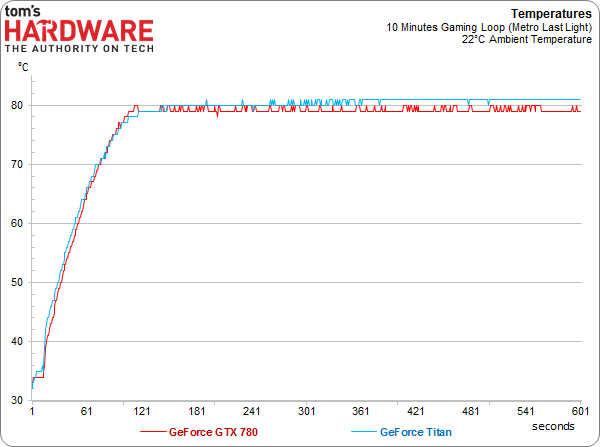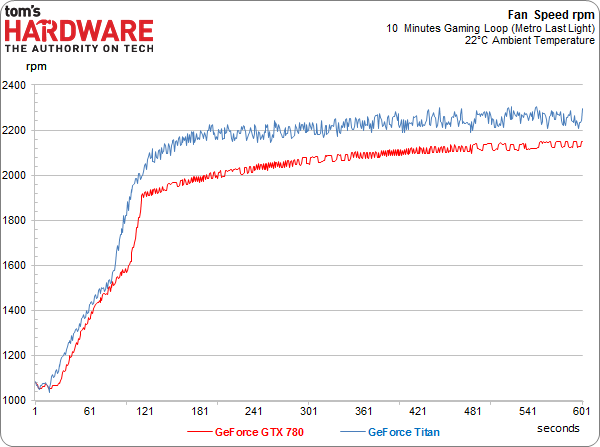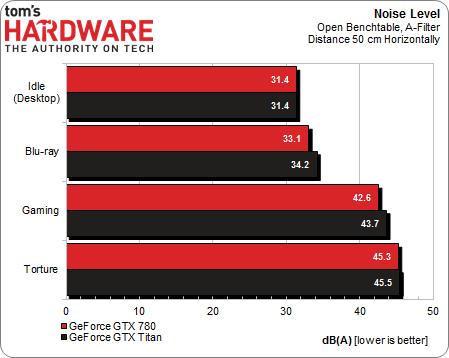Nvidia GeForce GTX 780 Review: Titan’s Baby Brother Is Born
At $1,000, GeForce GTX Titan only made sense for folks building small form factor PCs and multi-GPU powerhouses. Now there's another option with every bit of panache, a slightly de-tuned GPU, and a price tag $350 lower: meet Nvidia's GeForce GTX 780.
Heat, Noise, And Cooling
Heat
The reference cooler's fan curve is quite conservative. For example, the cooler only begins to spin faster at around 60°C, finally kicking into high gear upwards of 75°C. A direct comparison between the GeForce GTX Titan and 780 reveals the latter’s maximum fan speed to be slightly lower. In our gaming loop, Nvidia’s new card runs about two degrees cooler than the Titan, resulting in a slightly lower fan speed and a more gradually rising fan speed curve. This is due to the aforementioned refinements to the card's fan controller.
Despite the minor differences already noted, the two cards’ fan speed and temperature graphs converge more and more as time goes by, although they never actually intersect. That’s surprising, considering the surgical changes Nvidia made to its GeForce GTX 780. Let’s keep that first graph showing the temperatures in mind when as we move on to the next page. Specifically, we want to check the correlation between the thermal target of 80°C and power consumption.
Noise
But first, let’s take a closer look at the new card’s noise output, with the GeForce GTX Titan serving as our reference point again:
The GeForce GTX 780 enjoys a small advantage in each of our scenarios, although the differences are too small to be noticeable. In light of this, you could even consider the results close enough to be a tie. We’ll try to explain why this is so on the next page.
Get Tom's Hardware's best news and in-depth reviews, straight to your inbox.
Current page: Heat, Noise, And Cooling
Prev Page Multi-GPU Results: Tomb Raider Next Page Power Consumption And GPU Boost-
CrisisCauser A good alternative to the Titan. $650 was the original GTX 280 price before AMD came knocking with the Radeon 4870. I wonder if AMD has another surprise in store.Reply -
It's definitely a more reasonable priced alternative to the titan, but it's still lacking in compute. Which might disappoint some but I don't think it'll bother most people. Definitely not bad bang for buck at that price range considering how performance scales with higher priced products, but it could've been better, $550-$600 seems like a more reasonable price for this.Reply
-
hero1 This is what I have been waiting for. Nice review and I like the multi gpu tests. Thanks. Time to search the stores. Woohoo!!Reply -
natoco To much wasted silicon (just a failed high spec chip made last year, even the titan) and rebadged with all the failed sections turned off. I wanted to upgrade my gtx480 for a 780 but for the die size, the performance is to low unfortunately. It has certainly not hit the trifecta like the 680 did. Would you buy a V8 with 2 cylinders turned off even if it were cheaper? No, because it would not be as smooth as it was engineered to be, so using that analogy, No deal. customer lost till next year when they release a chip to the public that's all switched on, will never go down the turned off parts in chip route again.Reply -
EzioAs In my opinion, this card and the Titan is actually a clever product release by Nvidia. Much like the GTX 680 and GTX 670, the Titan was released at higher price (like the GTX 680) while the slightly slower GTX 780 (the GTX670 for the GTX600 series case) is at a significantly lower price but performing quite close to it's higher-end brother. We all remember when the GTX 670 launched it makes the GTX680 looks bad because the GTX 670 was 80% of the price while maintaining around 90-95% of the performance.Reply
Of course, one could argue that as we get closer to higher-end products, the performance increase is always minimal and price to performance ratio starts to increase, however, for the past 3-4 years (or so I guess), never has it been that the 2nd highest-end GPU having such low performance difference with the highest-end GPU. It's usually significant enough that the highest end GPU (GTX x80) still has it's place.
Tl;dr,
The GTX Titan was released to make the GTX 780 look incredibly good, and people (especially on the internet), will spread the news fast enough claiming the $650 release price for the GTX 780 is good and reasonable, and people who didn't even bother reading reviews and benchmarks, will take their word and pay the premium for GTX 780.
Nvidia is taking a different route to compete with AMD or one could say that they're not even trying to compete with AMD in terms of price/performance (at least for the high-end products). -
mouse24 natocoTo much wasted silicon (just a failed high spec chip made last year, even the titan) and rebadged with all the failed sections turned off. I wanted to upgrade my gtx480 for a 780 but for the die size, the performance is to low unfortunately. It has certainly not hit the trifecta like the 680 did. Would you buy a V8 with 2 cylinders turned off even if it were cheaper? No, because it would not be as smooth as it was engineered to be, so using that analogy, No deal. customer lost till next year when they release a chip to the public that's all switched on, will never go down the turned off parts in chip route again.Reply
Thats apretty bad analogy. A gpu is still smooth even with some of the cores/vram/etc turned off, it doesn't increase latency/frametimes/etc. -
godfather666 "But, I’m going to wait a week before deciding what I’d spend my money on in the high-end graphics market. "Reply
I must've missed something. Why wait a week? -
JamesSneed Natoco, your comment was so clueless. It is likely every single CPU or GPU you have ever purchased has fused off parts. Even the $1000 extreme Intel cpu has a little bit fused off since its a 6 core CPU but using a 8 core Zeon as its starting point. Your comparison to a car is idiotic.Reply -
016ive You will have to be an idiot to buy a Titan now that the 780 is here...Me, I could afford neither :)Reply



